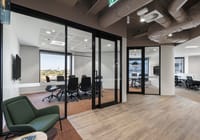
Soaking it all in at Gippsland's latest tourist attraction
Bringing the niche Gippsland tourism product of the Metung Hot Springs to public presentation has taken a very long time:
It took millennia for nature to bring the geothermal, mineral-loaded waters to an ideal 45 degrees. It then took a drilling accident for them to be discovered in the 1920s, and subsequently, epic persistence on the part of the business operators who sensed the potential of a rebooted wellness destination in an Australian sector currently worth an annual $546 million.
It also required the engagement of the perfect architect. Chris Stanley knew that the site on the shore of Lake King at Metung required his work to be “the subservient addition … to sit secondary to the landscape”.
“The experience is always the hero,” he says.
The Metung Hot Springs that opened – or re-opened – late last year with an offering of seven thermal pools, geothermal showers, 10 water-lapped glamping tents, quirky individual bathing barrels and a range of hands-on treatments, is only the first part of the development that will keep Stanley’s Splinter Society architecture practice at the task for another decade.
As it is, the springs can cater for 50 visitors a day – those who want to take the waters plus those staying over in the glamping accommodation.
In 10 years, when what the site partners call “the big ambition” of building a 250-room hotel, a larger bathing centre, a marina and – you’ll have to imagine this one – floating thermal baths on the lake have been added, co-owner Adrian Bromage says it should “be a really world-class experience for our region”.
After drillers found hot water rather than oil in the Gippsland Lakes region, the thermal pools became a locals’ indulgence. Later, the pools had a phase as a minor destination for a hot soak until the daggy infrastructure became dilapidated and they closed in the 1990s.
But Metung-based accommodation owners Adrian and Rachel Bromage harboured a vision for reinventing the place. As far back as 2008 they discussed the idea with the chief executive of the phenomenally successful Peninsula Hot Springs on the Mornington Peninsula.
Little more happened until four years ago when the 10.1-hectare farmland at Kings Cove that surrounded the pools came up for sale and the Bromages bought it. Charles came in on the deal with them and a long process commenced to find the right site designer for the long term.
Although different tenders were considered, the job was awarded to Splinter Society who pitched only in writing, with the winning line that the overarching goal should be “to work with the exceptional beauty of the site using a regenerative model and to create an end product that could, in future, be classified as a national park,” Stanley says.
For 25 years, the signature style of Stanley’s practice has been chunky, raw, robust and honest. When he began formulating how the springs should be presented, he camped for days at various spots on the land to figure out “how to allow the natural systems to come back in and co-exist with people”.
“Everywhere on the site, you can feel how the water has shaped it over many millions of years,” he says.
It is very much Stanley’s way to go with the flow like this. He worked with regional East Gippsland contactors, one of whom has large limestone boulders on his own land 70 kilometres further up one of the watersheds that feed the lakes and who fetched in much of the 18,000 tonnes of rocks that have been installed into the landscapes Stanley has gently carved and reformed for the project.
The architect went to local quarries and sawmills – “all sites within cooee” – to select or recycle the hardwood timbers that can be seen “in their natural beauty” in the infrastructure to give it “a genuine feel”. The pebbles that make up the reflexology walk were a readier resource, he says: “Little river pebbles from all parts of the alps were on the land. Pebbles in a phenomenal range of colours.”
The glamping platforms on the edge of Kings Lagoon went up quickly because they sit up “on light screw piles among the Banksias, above the wombat burrows”.
“There’s a lot of activity on that bank,” Stanley says. “With all the birds and insects, it’s a real experience of being on the lakes”.
The wine barrels for individual bathing are … wine barrels. As eccentric as they might seem in a wellness resort, they’ve been installed to conserve the spring water that is eventually recycled onto the next-door golf course that the springs’ consortium has also bought. More development is planned for that added attraction.
Bromage, a former Australian rules footy player, has a story to back up his claim that, in Metung, “there was a 95 per cent approval for us taking over the golf course”, and an apparent welcome of the promise of trans-seasonal tourism that the springs are starting to bring into a township of 2200 permanent residents.
“We see the old guys, the golfers, coming down in their carts now to utilise the pools – and the wine barrels.”










